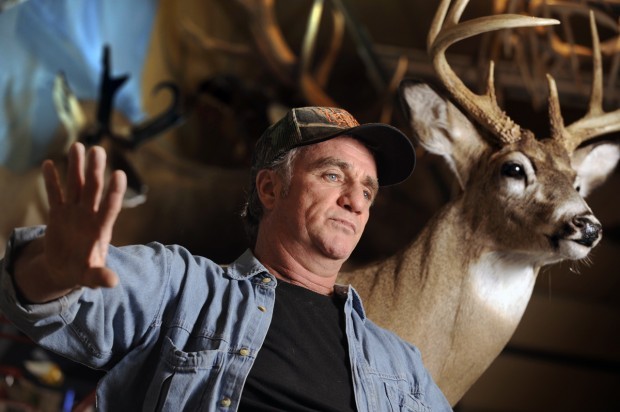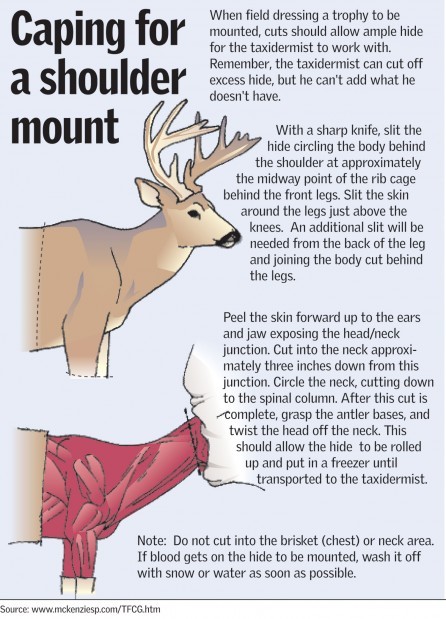Taxidermist Tells How To Preserve Trophy Quality
BRETT FRENCH Of The Gazette Staff
Posted in the Billings Gazette: Thursday, October 29, 2009

Photo by: JAMES WOODCOCK/Billings Gazette Staff
Billings taxidermist Dean Emmick talks about the correct way
to cape an animal ifthe hunterwants his trophy mounted.
Hunters shouldn't expect Dean Emmick to save their skin.
"This is the kind of crap I get all the time," Emmick, 49, complained while pointing to a mule deer hide laid across the floor of his Billings taxidermy shop. Improperly removed, there was little usable hide left along the brisket at the base of the deer's neck and the deer's skin around its legs had been split. "It's bad news for you, because I either have to patch it or buy a replacement cape or you have to get another one," he said. The only other alternative is to use a smaller mold for the mount, a short-necked pose Emmick isn't fond of using. "A wall or pedestal mount shows more of the shoulder and muscle detail," Emmick said. "The options are there if they do their field preparation right." To help hunters properly field dress their game without butchering its chance to be mounted as a trophy, Emmick will be conducting a seminar at Cabela's on Saturday at 2 p.m. and again on Nov. 14 at 2 p.m.
Museum work
Emmick and his brother, Darrol, have operated All Phases Taxidermy in Billings since 1983. Dean said he became interested in taxidermy when he was only 10 and began doing his own work at 12. In 2001 and 2002, the brothers worked in the Draper Museum of Natural History in Cody, Wyo., helping to prepare wildlife mounts set in the animals' natural surroundings. "It helped working at the Draper with three world champion taxidermists; that opens your eyes," Emmick said. In an average year, the three-man taxidermy shop will work on anywhere from 30 to 100 mounts a season. Most of those come in during the latter part of the season, when bucks are shot during the rut, he said. Because of the steps involved and how many customers there are, it can take a year to three years for a mount to be completed. "Last year was a lot slower because people were worried about the economy," Emmick said. He predicted his taxidermy business would pick up this year.
Tips for skinning
Before the Emmicks, or any taxidermist, can do their work properly, it helps if the hunter takes care of the animal in the field. Here's what Emmick recommends:
• Try to keep the animal as clean as possible. Don't drag it through the mud, in fact, don't drag it at all. When gutting it, pull the entrails out downhill and away from the carcass. "The cleaner you bring your specimen to me, the better for you," he said.
• With birds, don't gut the animals, and keep the feathers as smoothed and clean as possible. Don't hold the bird by the neck; that will break the delicate neck feathers. Don't get the feathers wet. And don't bring in a bird that's been badly shot up.
• On a deer, antelope, moose or elk, don't cut any farther forward than the back of the shoulder.
"A guy came in a couple of years ago with a beautiful, beautiful whitetail … and he'd cut its throat. He ended up buying another cape," Emmick said. To remove the hide for a shoulder mount, cut up the backbone to the base of the skull. Cut around the front legs just above the second joint. Then peel the hide down, leaving the legs like tubes. Cut the head off at the base of the skull. If you're unsure how to proceed, bring it to your taxidermist to do the skinning. The Emmicks also recommend measuring the circumference of the animal's neck using a flexible tape tightly wrapped just below the jaw and around to the backbone. For those who mess up, the cost to purchase a hide can range from around $100 to $200 for a deer or antelope, and double that for an elk.

Dusty memories
Emmick still has the first duck he ever mounted hanging from the ceiling of his shop, along with an aging and yellowed antelope head that was the first he mounted. They are reminders, he said, of just how much better he is at his work now. They also remind him of his mother, who kept the duck and refused to throw it out despite Emmick's protests. "This is so you can appreciate where you are," Emmick's mother told him. There's also a "Rocky" the squirrel, taxidermied when Emmick was 13. The squirrel now holds a large nut in its tiny forepaws while wearing a small brown cowboy hat and brass wire-rimmed spectacles. Emmick likes that the talent he's developed over the years can help hunters bring a bit of nature or an exciting encounter with a game animal back home with them.
"You can enjoy the beauty of that animal forever," he said. |


